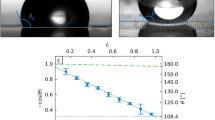Abstract
The transport of a small amount of liquid on a solid is not a simple process, owing to the nature of the contact between the two phases. Setting a liquid droplet in motion requires non-negligible forces (because the contact-angle hysteresis generates a force opposing the motion1), and often results in the deposition of liquid behind the drop. Different methods of levitation—electrostatic, electromagnetic, acoustic2, or even simpler aerodynamic2,3 techniques—have been proposed to avoid this wetting problem, but all have proved to be rather cumbersome. Here we propose a simple alternative, which consists of encapsulating an aqueous liquid droplet with a hydrophobic powder. The resulting ‘liquid marbles’ are found to behave like a soft solid, and show dramatically reduced adhesion to a solid surface. As a result, motion can be generated using gravitational, electrical and magnetic fields. Moreover, because the viscous friction associated with motion is very small4, we can achieve quick displacements of the droplets without any leaks. All of these features are of potential benefit in microfluidic applications, and also permit the study of a drop in a non-wetting situation—an issue of renewed interest following the recent achievement of super-hydrophobic substrates5.




Similar content being viewed by others
References
Dussan, V. E. B. & Chow, R. T. P. On the ability of drops or bubbles to stick to non-horizontal surfaces of solids. J. Fluid Mech. 137, 1–29 (1983).
Frohn, A. & Roth, R. Dynamics of Droplets (Springer, Berlin, 2000).
Perez, M. et al. Oscillation of liquid drops under gravity: influence of shape on the resonance frequency. Europhys. Lett. 47, 189–195 (1999).
Mahadevan, L. & Pomeau, Y. Rolling droplets. Phys. Fluids 11, 2449–2453 (1999).
Onda, T., Shibuichi, S., Satoh, N. & Tsujii, K. Super water-repellent fractal surfaces. Langmuir 12, 2125–2127 (1996).
Taylor, G. I. & Michael, D. H. On making holes in a sheet of fluid. J. Fluid Mech. 58, 625–639 (1973).
Richard, D. & Quéré, D. Drops rolling on a tilted non-wettable solid. Europhys. Lett. 48, 286–291 (1999).
Wang, T. G. et al. Bifurcation of rotating liquid drops: results from USML-1 experiments in space. J. Fluid Mech. 276, 389–403 (1994).
Lee, C. P. et al. Equilibrium of liquid drops under the effects of rotation and acoustic flattening: results from USML-2 experiments in space. J. Fluid Mech. 354, 43–67 (1998).
Brown, R. A. & Scriven, L. E. The shape and stability of rotating liquid drops. Proc. R. Soc. Lond. A 371, 351–367 (1980).
Brown, R. A. & Scriven, L. E. New class of asymmetric shapes of rotating liquid drops. Phys. Rev. Lett. 45, 180–183 (1980).
Rayleigh,Lord The equilibrium of revolving liquid under capillary force. Phil. Mag. 28, 161–170 (1914).
Plateau, J. A. F. Experimental and theoretical researches on the figures of equilibrium of a liquid mass withdrawn from the action of gravity. Annu. Rep. Board Regents Smithson. Inst. 207–285 (1863).
Chandrasekhar, S. The stability of a rotating liquid drop. Proc. R. Soc. Lond A 286, 1–26 (1965).
Acknowledgements
We thank J. Bico and D. Richard for silanization of lycopodium grains and the achievement of a first series of liquid marbles, C. Clanet for help with high-speed pictures and for discussions, and P.-G. de Gennes for discussions and encouragement.
Author information
Authors and Affiliations
Corresponding author
Rights and permissions
About this article
Cite this article
Aussillous, P., Quéré, D. Liquid marbles. Nature 411, 924–927 (2001). https://doi.org/10.1038/35082026
Received:
Accepted:
Issue Date:
DOI: https://doi.org/10.1038/35082026
- Springer Nature Limited
This article is cited by
-
Fabrication of stable monolayer liquid marbles with reduced particle coverage and locomotion on hydrophilic surface
Communications Materials (2024)
-
Crystallization of molecular layers produced under confinement onto a surface
Nature Communications (2024)
-
Pavlovian Reflex in Colloids
BioNanoScience (2024)
-
Tailoring vapor film beneath a Leidenfrost drop
Nature Communications (2023)
-
Fluorine-free superhydrophobic PDMS-coated silica particles for oil–water separation and liquid marbles
Journal of Materials Science (2023)





